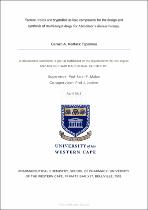| dc.description.abstract | The cascade of neurotoxic events involved in the pathogenesis of Alzheimer's disease may explain the inefficacy of currently available treatment based on acetylcholinesterase inhibitors (AChEI - donepezil, galantamine, rivastigmine) and N-methyl-D-aspartate (NMDA) antagonists (memantine). These drugs were designed based on the "one-moleculeone- target" paradigm and only address a single target. Conversely, the multi-target drug design strategy increasingly gains recognition. Based on the versatile biological activities of tacrine, trolox and β-carboline derivatives, the attention they have received as lead structures for the design of multifunctional drugs for the treatment of Alzheimer's disease, and the topology of the active site of AChE, we have designed tacrine-trolox and tacrine-tryptoline hybrids with various linker chain lengths. The aim with these hybrids was to provide additive or synergistic therapeutic effects that might help overcome the limitation of current anti Alzheimer's disease drugs. All synthesized compounds were designed from lead structures (tacrine, tryptoline and trolox) to obtain cholinesterase (ChE) multisite binders and multifunctional AD agents. The study was rationalized by docking all structures in the active site of TcAChE using Molecular Operating Environment (MOE) software before proceeding with the synthesis. ChE inhibition was assessed in a UV enzyme inhibition assay using Ellman's method. Antioxidant activities were assessed using the 2, 2-diphenyl-1-picrylhydrazyl (DPPH.) absorbance assay. The hybrids containing the trolox moiety (compounds 8a-e) showed moderate to high AChE inhibitory activity in the nano to micro molar range (IC₅₀: 17.37 - 2200 nM), BuChE inhibition was observed in the same range (IC₅₀: 3.16 – 128.82 nM), and free radical scavenging activities in micro molar range (IC50: 11.48 – 49.23 µM). These are comparable or slightly higher than their reference compounds donepezil (AChE IC₅₀ = 220 nM), tacrine (BuChE IC₅₀: 14.12 nM), and trolox (DPPH IC₅₀: 17.57 µM). The hybrids with longer linker chain lengths, 6 and 8 carbons (8d and 8e), showed better ChE inhibitory activity than the shorter ones, 2, 3, and 4 carbons (8a-c respectively). This correlates well with literature. Free radical scavenging activities, however, seems not to be significantly affected by varying linker chain lengths. The hybrid compound (14) containing the tryptoline moiety linked with a 7 carbon spacer displayed the best AChE and BuChE inhibitory activity (IC₅₀ = 17.37 and 3.16 nM) but poor free radical scavenging activity. Novel anti-Alzheimer's disease drugs
with multi-target neuroprotective activities were thus obtained and hybrid molecules that exhibit good ChE inhibition (8d, 8e and 14) and anti-oxidant (8d and 8e) activity were identified as suitable candidates for further investigation. | en_US |

